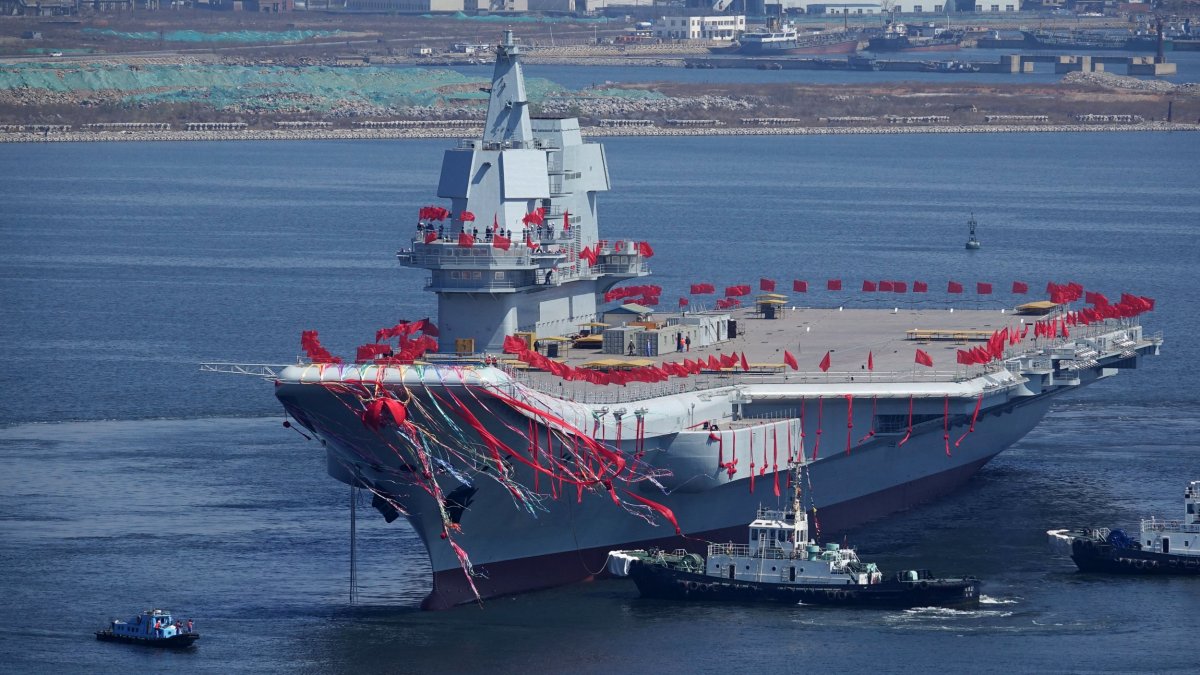The Chinese government has revealed its latest aircraft carrier project, which will provide the People's Liberation Army (PLA) Navy with its third warship—giving the country a fleet second only in size to the U.S.
The state-run Xinhua News Agency published an article Sunday on its Weibo account—a popular Chinese social media platform—which said that a "new-generation" carrier is currently under construction, China Daily reported.
Xinhua's article was published to mark the sixth anniversary of the first takeoff and landing of a Chinese fighter jet on the country's first aircraft carrier—the CNS Liaoning. The former Soviet Kuznetsov-class carrier was procured from Ukraine and introduced into Chinese service in 2012.
This was only the beginning of China's aircraft carrier ambitions. The Liaoning has been useful in training Chinese sailors and pilots, but the country's domestically produced carriers represent the ultimate naval goal of the Communist Party.
The first such carrier—currently known as the Type 001A—was put to sea last year and has been undertaking a wide range of sea trials. It is expected to be introduced into full service around the end of 2018.
The Xinhua article gave no further detail on the planned vessel, which will be China's second home-grown carrier. According to China Daily, domestic military experts and foreign observers believe it to be under construction at the China State Shipbuilding Corp's Jiangnan Shipyard Group in Shanghai.
According to CNN, Xinhua explained, "Six years have passed, our domestic carrier has been trialed, entry into service is just around the corner. The new aircraft carrier has also been built on the slipway."

The newest vessel—referred to by some as the Type 002—is expected to be larger and more advanced than both the Lioniang and the Type 001A. According to the Global Times, it is likely to be ready for trials by 2020 and full service by 2023.
The Type 001A—which will be named when brought into full service—is currently the most advanced Chinese carrier. Steam-powered, the 1,033-foot ship will have a full load displacement of around 77,000 tons, according to The New York Times, and will be able to carry 48 aircraft when deployed.
Though the Type 001A represents a huge leap in Chinese military development, even its latest carrier is significantly smaller than the U.S. Navy's Nimitz-class nuclear-powered supercarriers. The USS George H.W. Bush—the most recent Nimitz-class carrier—is 1,092-feet long, displaces around 102,000 tons and generally carries up to 56 fixed-wing aircraft.
The U.S. currently has 11 aircraft carriers in service—more than the rest of the world combined. This includes the lead ship of the new Gerald R. Ford-class range, the first of which—the USS Gerald R. Ford—came into service in 2017. It is expected to be fully deployed by the early 2020s and will eventually followed by another nine vessels of the same class.
An article published on the official website of the PLA in June suggested the Type 002 will be equipped with an electromagnetic aircraft launch system—similar to those used by the U.S. Navy's Gerald R. Ford-class carriers.
For China, a modern naval arm including multiple aircraft carriers is vital in pursuing its regional interests and establishing itself as a global military force.
Two of the country's most pressing strategic questions are those of Taiwan and the South China Sea. In both cases, Beijing and Washington could find themselves in a confrontation. Thus it is vital for China to have a modern force capable at least of challenging American hegemony, if not establishing regional dominance of its own.
Uncommon Knowledge
Newsweek is committed to challenging conventional wisdom and finding connections in the search for common ground.
Newsweek is committed to challenging conventional wisdom and finding connections in the search for common ground.
About the writer
David Brennan is Newsweek's Diplomatic Correspondent covering world politics and conflicts from London with a focus on NATO, the European ... Read more
To read how Newsweek uses AI as a newsroom tool, Click here.








